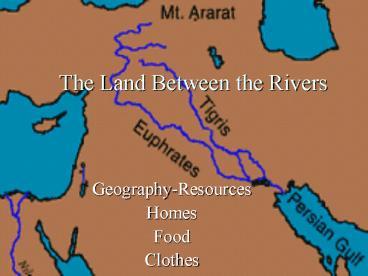The Land Between the Rivers - PowerPoint PPT Presentation
1 / 24
Title:
The Land Between the Rivers
Description:
The Land Between the Rivers Geography-Resources Homes Food Clothes Land and Climate in Mesopotamia I. LAND AND CLIMATE A. Characteristics - rolling hills 1 ... – PowerPoint PPT presentation
Number of Views:412
Avg rating:3.0/5.0
Title: The Land Between the Rivers
1
The Land Between the Rivers
- Geography-Resources
- Homes
- Food
- Clothes
2
Land and Climate in Mesopotamia
- I. LAND AND CLIMATE
- A. Characteristics - rolling hills
- 1. tillable soil, light rain
- 2. intense sun, relentless wind
- B. No natural barriers
- 1. Armenian (Zagros) hills lie to
- north
- 2. Arabian desert to south
3
(No Transcript)
4
Good Effects Bad Effects
Encourage Trade Easy Access to Invader
Spread Ideas Communication Flooding
Transportation
See approaching people
5
Prediction Ideas of this culture
could be easily spread to others and
easily conquered by others.
6
Resources Needs
Clay Stone Wood Mts from the north
Water Cedar Wood From Lebanon
Cloth Metals From Persia
Grain- Wheat and Barley Spices, Dyes, Jewels From India
Reeds, Palms
7
(No Transcript)
8
FOOD IN SUMER
- I. People in ancient Sumer ate
- A. bread from wheat
- B. cereals from emmer, wheat,
- and millet (a grass)
- C. barley (grew well in saline soil) was
- used for
- 1. flour
- 2. porridge
- 3. the basis of an ancient beer
- 4. the first basis of money
9
Emmer Wheat
Wheat Grain
Barley Fields
Wheat Fields
10
FOOD IN SUMER
- Other Foods (mentioned on clay tablets)
- Few Meats (wealthy) like sheep, goats, lamb,
cattle - salted - Fish, shellfish, birds, turtles
- Honey, Syrups
- Seeds, nuts (pistachio)
- Dairy products - sour
- Fruits (apples, pears, plums, figs, raisins,
pomegranates, dates, melons, cucumbers) - Onion, Garlic, Leeks
- Soups/Stews -
11
Figs
Pomegranates
Dates
Stew
Pistachios
12
Foot Sowing Plow
13
- Farming was the oldest and largest occupation.
The oldest literature is a - Farmer's Almanac that is over 5000
- years old.
Clay Sickle
14
Earlier Sumerian Homes These were huts made from
two of their main natural resources mud and reed
15
(No Transcript)
16
Homes In Sumer
- I. General Design
- A. Flat roofed, one-story high
- B. Walls more than 10 feet high
- C. Built of mud, white-washed in and out
- D. Several rooms built around an open
- courtyard
17
(No Transcript)
18
- II. Interior
- A. Furniture made of wood
- B. Reed mats, skin rugs, wall hangings
- C. Utensils made of stone, bronze or
copper - III. Upper class homes
- A. Two-story kitchen/reception room,
- bedrooms, bathrooms, private chapel
- B. Burial crypt under house
19
(No Transcript)
20
Clothing Styles in Sumer
- I. Basic parts of ancient Sumerian clothing
- A. Skirts (called karnakes)
- 1. Some had fringe in layers that kept the
material from unraveling. The larger or more
layers of the fringe, the higher the social
status of the person. - B. Shawls ( of sheepskin)
- C. Headdress
21
- II. Women wore skirts and shawls with
turbans on their heads. Wealthier or royal had
elaborate headdresses. - III. Men wore shorter skirts and shaved their
heads. Outsiders wore beards. Sometimes priests
also had beards. Soldiers wore short leather
skirts and tight-fitting copper helmets. - Draw a picture of Women's clothing and Men's
clothing below (make sure to label parts)
22
Statues
We learn from
Steles
Artifacts
23
Carnelian
Instruments
Lapis Lazuli
Games
Jewelry
24
Ask yourself How is my way of life alike and
different from life in Sumer?































